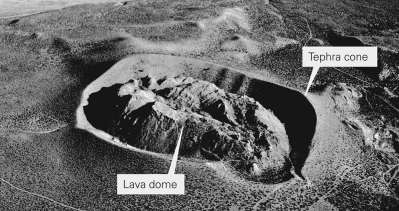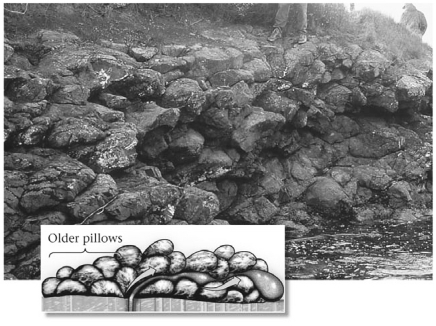A) stratovolcanoes
B) cinder cones
C) shield volcanoes
D) fissure volcanoes
Correct Answer

verified
Correct Answer
verified
Multiple Choice
Volcanic bombs are ________.
A) volcanic fragments that were ejected while still soft or molten
B) explosive bodies of lava with high volatile content
C) volcanic fragments that were already solid rock before being ejected during an eruption
D) used by geologists to set off small eruptions in volcanoes that are deemed potentially dangerous
Correct Answer

verified
Correct Answer
verified
Multiple Choice
Which of the following is NOT true? Hot-spot volcanoes ________.
A) can arise from the ocean floor
B) can arise on continents
C) can arise in the interior of lithospheric plates
D) always produce mafic lava flows
Correct Answer

verified
Correct Answer
verified
Multiple Choice
Phreatic eruptions take place when ________.
A) volatiles effervesce prior to lava flow
B) groundwater interacts with magma
C) basaltic lava clogs the eruptive vent
D) lava or pyroclastic debris erupts by bursting through the sides of the volcano
Correct Answer

verified
Correct Answer
verified
Multiple Choice
Gases that are abundantly emitted by volcanoes include ________.
A) water vapor,carbon dioxide,and sulfur dioxide
B) oxygen,ozone,and water vapor
C) oxygen,hydrogen,and argon
D) carbon dioxide,carbon monoxide,and oxygen
Correct Answer

verified
Correct Answer
verified
Multiple Choice
Compared to felsic lavas,mafic lavas have a ________.
A) lighter color
B) lower viscosity
C) lower density
D) higher silica content
Correct Answer

verified
Correct Answer
verified
Multiple Choice
The image below shows a lava dome that never left the volcanic crater.What is the likely composition of the rocks that make up this lava dome? 
A) felsic
B) intermediate
C) mafic
D) ultramafic
Correct Answer

verified
Correct Answer
verified
Multiple Choice
Nonviolent eruptions characterized by extensive flows of basaltic lava are termed ________.
A) pyroclastic
B) effusive
C) explosive
D) plinian
Correct Answer

verified
Correct Answer
verified
Multiple Choice
Pele's hair ________.
A) consists of thin strands of basaltic glass
B) acquires aerodynamic torpedo-like shapes during flight out of the volcanic vent
C) forms only at the leading edge of basaltic lava flows
D) forms when volcanic ash erupts into a rain cloud
Correct Answer

verified
Correct Answer
verified
Multiple Choice
Volcanoes have provided some positive benefits to humankind and life in general over geologic time.Which of the following is NOT true about volcanoes?
A) Volcanic eruptions can enrich soils,making land more fertile.
B) Volatiles from volcanoes provided much of our early oceans' water.
C) Volcanic eruptions have prevented several mass extinctions by cooling Earth's climate.
D) Gasses from volcanic eruptions provided much of the content of the early atmosphere.
Correct Answer

verified
Correct Answer
verified
Multiple Choice
Which of the following poses the greatest hazard to human life associated with volcanoes?
A) flowing lava
B) volcanic gas
C) falling ash
D) pyroclastic flows
Correct Answer

verified
Correct Answer
verified
Multiple Choice
The Columbia River Plateau is an example of a ________.
A) caldera
B) fissure
C) flood basalt
D) hot spot
Correct Answer

verified
Correct Answer
verified
Multiple Choice
The lithification of material from a pyroclastic flow forms a rock called ________.
A) tephra
B) ignimbrite
C) lapilli
D) air-fall tuff
Correct Answer

verified
Correct Answer
verified
Multiple Choice
Rhyolitic lavas ________.
A) do not flow as far from the vent as basaltic lavas do
B) are commonly found at oceanic hot spots
C) are associated with volcanoes that almost never emit pyroclastic debris
D) are commonly found on shield volcanoes
Correct Answer

verified
Correct Answer
verified
Multiple Choice
The Hawaiian island chain is an example of a(n) ________.
A) island volcanic arc
B) continental volcanic arc
C) hot-spot island chain
D) stratovolcanic assembly
Correct Answer

verified
Correct Answer
verified
Multiple Choice
The difference between tephra and tuff is that ________.
A) tephra is created in ash falls,whereas tuff is created in pyroclastic flows
B) tephra is unlithified,whereas tuff is lithified
C) tephra is always felsic to intermediate,whereas tuff is always mafic
D) tephra is formed at stratovolcanoes while tuffs are formed at cinder cones
Correct Answer

verified
Correct Answer
verified
Multiple Choice
Based on your knowledge of volcanoes and volcanic products,you can say with confidence that the outcrop in the image below ________. 
A) formed on land at a continental hotspot
B) formed underwater at a subduction zone
C) formed on land at a continental rift
D) formed underwater at a mid-ocean ridge
Correct Answer

verified
Correct Answer
verified
Multiple Choice
Which of the following is true concerning the 1980 eruption of Mt.St.Helens?
A) The eruption was a complete surprise to geologists and provided no forewarning.
B) The eruption produced the largest basalt flow of the 20th century anywhere on Earth.
C) The eruption began with a lateral blast of debris that was ejected at the speed of sound.
D) No lahars were produced because the eruption occurred in the winter.
Correct Answer

verified
Correct Answer
verified
Multiple Choice
Scientists monitor volcanoes to help predict when eruptions will occur.Which of the following is NOT a potential sign to look for when predicting volcanic eruptions?
A) changes in earthquake activity
B) changes in Earth's magnetic field
C) small changes in the shape of the volcano
D) increases in gas and steam emissions
Correct Answer

verified
Correct Answer
verified
Multiple Choice
Olympus Mons,the largest known volcano in our Solar System,is an example of a ________.
A) stratovolcano
B) cinder cone
C) shield volcano
D) fissure volcano
Correct Answer

verified
Correct Answer
verified
Showing 21 - 40 of 50
Related Exams